
An electric unicycle is a self-balancing personal transporter with a single wheel. The rider controls speed by leaning forwards or backwards, and steers by twisting or tilting the unit side to side. The self-balancing mechanism uses accelerometers and gyroscopes. Most manufacturers of EUCs are based out of China, including Segway, Inmotion, Kingsong, Begode, and Leaperkim.
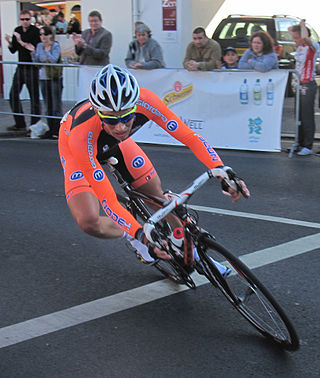
Steering is the control of the direction of motion or the components that enable its control. Steering is achieved through various arrangements, among them ailerons for airplanes, rudders for boats, cylic tilting of rotors for helicopters, and many more.

A single-track vehicle is a vehicle that leaves a single ground track as it moves forward. Single-track vehicles usually have little or no lateral stability when stationary but develop it when moving forward or controlled. In the case of wheeled vehicles, the front and rear wheel usually follow slightly different paths when turning or when out of alignment.

Suspension is the system of tires, tire air, springs, shock absorbers and linkages that connects a vehicle to its wheels and allows relative motion between the two. Suspension systems must support both road holding/handling and ride quality, which are at odds with each other. The tuning of suspensions involves finding the right compromise. The suspension is crucial for maintaining consistent contact between the road wheel and the road surface, as all forces exerted on the vehicle by the road or ground are transmitted through the tires' contact patches. The suspension also protects the vehicle itself and any cargo or luggage from damage and wear. The design of front and rear suspension of a car may be different.
Automobile handling and vehicle handling are descriptions of the way a wheeled vehicle responds and reacts to the inputs of a driver, as well as how it moves along a track or road. It is commonly judged by how a vehicle performs particularly during cornering, acceleration, and braking as well as on the vehicle's directional stability when moving in steady state condition.

In both road and rail vehicles, the wheelbase is the horizontal distance between the centers of the front and rear wheels. For road vehicles with more than two axles, the wheelbase is the distance between the steering (front) axle and the centerpoint of the driving axle group. In the case of a tri-axle truck, the wheelbase would be the distance between the steering axle and a point midway between the two rear axles.
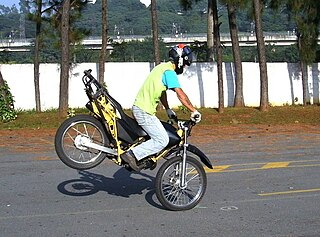
Weight transfer and load transfer are two expressions used somewhat confusingly to describe two distinct effects:

Countersteering is used by single-track vehicle operators, such as cyclists and motorcyclists, to initiate a turn toward a given direction by momentarily steering counter to the desired direction. To negotiate a turn successfully, the combined center of mass of the rider and the single-track vehicle must first be leaned in the direction of the turn, and steering briefly in the opposite direction causes that lean. The rider's action of countersteering is sometimes referred to as "giving a steering command".

A three-wheeler is a vehicle with three wheels. Some are motorized tricycles, which may be legally classed as motorcycles, while others are tricycles without a motor, some of which are human-powered vehicles and animal-powered vehicles.
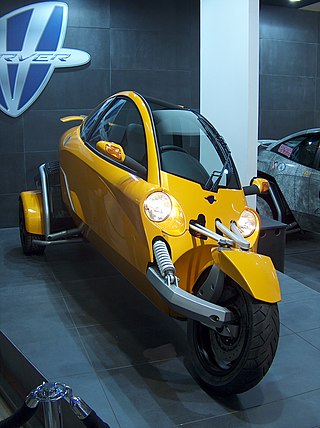
A tilting three-wheeler, tilting trike, leaning trike, or even just tilter, is a three-wheeled vehicle and usually a narrow-track vehicle whose body and or wheels tilt in the direction of a turn. Such vehicles can corner without rolling over despite having a narrow axle track because they can balance some or all of the roll moment caused by centripetal acceleration with an opposite roll moment caused by gravity, as bicycles and motorcycles do. This also reduces the lateral acceleration experienced by the rider, which some find more comfortable than the alternative. The narrow profile can result in reduced aerodynamic drag and increased fuel efficiency. These types of vehicles have also been described as "man-wide vehicles" (MWV).

An adhesion railway relies on adhesion traction to move the train, and is the most widespread and common type of railway in the world. Adhesion traction is the friction between the drive wheels and the steel rail. Since the vast majority of railways are adhesion railways, the term adhesion railway is used only when it is necessary to distinguish adhesion railways from railways moved by other means, such as by a stationary engine pulling on a cable attached to the cars or by a pinion meshing with a rack.
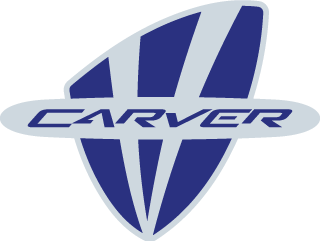
Carver Europe B.V. was a Dutch company that developed and manufactured three-wheeled electric enclosed man-wide vehicles. The company's core technology was the Dynamic Vehicle Control (DVC) system, which enables narrow vehicles to make banked turns, aiding stability when turning at high speeds.
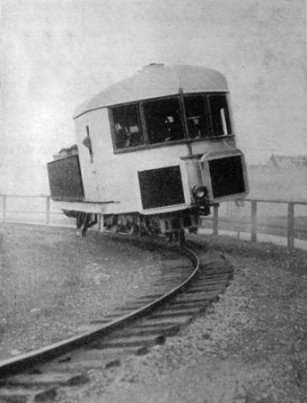
The gyro monorail, gyroscopic monorail, gyro-stabilized monorail, or gyrocar are terms for a single rail land vehicle that uses the gyroscopic action of a spinning wheel to overcome the inherent instability of balancing on top of a single rail.

The CLEVER is a type of tilting three-wheeled motor vehicle that was developed in a collaboration between the University of Bath, BMW and a number of other partners from across Europe. CLEVER is designed as an alternative to conventional means of personal urban transport. The narrow body endows it with some of the manoeuvrability and congestion avoiding capability of a motorcycle, whilst offering comparable weather and impact protection to a car. Carbon emissions are reduced as a function of low weight and a small frontal area. The narrow track width requires that CLEVER tilts into corners to maintain stability; thus it is fitted with a Direct Tilt Control (DTC) system that uses hydraulic actuators linking the cabin to the non-tilting rear engine module.

Bicycle and motorcycle dynamics is the science of the motion of bicycles and motorcycles and their components, due to the forces acting on them. Dynamics falls under a branch of physics known as classical mechanics. Bike motions of interest include balancing, steering, braking, accelerating, suspension activation, and vibration. The study of these motions began in the late 19th century and continues today.
Cornering Brake Control (CBC) is an automotive safety measure that improves handling performance by distributing the force applied on the wheels of a vehicle while turning corners. Introduced by BMW in 1992, the technology is now featured in modern electric and gasoline vehicles such as cars, motorcycles, and trucks. CBC is often included under the Electronic Stability Control (ESC) safety feature provided by vehicle manufacturers.

Bicycle and motorcycle geometry is the collection of key measurements that define a particular bike configuration. Primary among these are wheelbase, steering axis angle, fork offset, and trail. These parameters have a major influence on how a bike handles.

A wheelie, or wheelstand, is a vehicle maneuver in vehicle acrobatics in which the front wheel or wheels come off the ground due to sufficient torque being applied to the rear wheel or wheels, or rider motion relative to the vehicle. Wheelies are usually associated with bicycles and motorcycles, but can be done with other vehicles such as cars, especially in drag racing and tractor pulling.

A tilting car is a type of automobile that has the ability to change the angle between the road and the bottom of the passenger cabin in a way that allows it to avoid rolling over while the vehicle is driving through a curve. Tilting is critically important for narrow-track vehicles because unlike wider vehicles, the acceleration required to make a non-tilting narrow vehicle skid during a curve is less than that required to make it roll over; tilting allows narrow-track vehicles to "lean into the curve". Tilting cars may have three or four wheels.

The cant of a railway track or camber of a road is the rate of change in elevation (height) between the two rails or edges of the road. This is normally greater where the railway or road is curved; raising the outer rail or the outer edge of the road creates a banked turn, thus allowing vehicles to travel round the curve at greater speeds than would be possible if the surface were level.



























